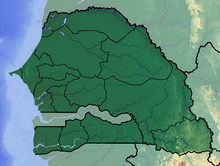The Great Mosque of Touba (Arabic: الجامع الكبير في توبا, French: Grande Mosquée de Touba) is a mosque in Touba, Senegal. It was founded by Ahmad Bamba in 1887 and completed in 1963. Bamba died in 1927 and was interred inside the mosque.[1] Since his death the mosque has been controlled by his family. It is the largest building in the city and one of the largest mosques in Africa, with a capacity of 7,000.[1] It is the site of a pilgrimage, the Grand Magal of Touba.
| Great Mosque of Touba | |
|---|---|
الجامع الكبير في توبا Grande Mosquée de Touba | |
 | |
| Religion | |
| Affiliation | Islam |
| Branch/tradition | Sunni |
| Location | |
| Location | Touba, Diourbel, Senegal |
| Geographic coordinates | 14°51′47.2″N 15°52′31.7″W / 14.863111°N 15.875472°W |
| Architecture | |
| Type | mosque |
| Capacity | 7,000 worshippers |
It is the home of the Mouride Brotherhood, a Sufi order, thus making it important to that order.[citation needed]
History edit
The construction of the great mosque at Touba was conceived in the final years of Ahmad Bamba's life, around 1924–27.[citation needed] He also chose it as the location for his tomb.[citation needed] Senegal's colonial rulers of the time, the French, agreed to the scheme in 1926, albeit after some hesitation.[citation needed] Construction was delayed because of the misappropriation of the first round of funds and then, under the direction of Mamadu Mustafâ Mbacke, Bamba's son and successor, proceeded only very slowly.[citation needed] In 1932, the foundations were completed; work paused in 1939–1947; and the building was inaugurated in 1963. Mamadu Mustafâ was also entombed there.[2]
Design edit
The mosque is 100 metres long and 80 metres wide.[citation needed] It has seven minarets, three large domes and eleven other domes, and two ablution chambers.[citation needed] The central minaret is 96 metres (315 feet) tall.[2]
The immediate vicinity of the mosque houses the mausoleum of Ahmad Bamba's sons, the caliphs of the Mouride order.[citation needed] Other institutions in the center of the holy city include a library boasting 160,000 volumes,[2] the Caliph's official audience hall, a sacred "Well of Mercy", and a cemetery.[citation needed]
The Great Minaret of the Great Mosque of Touba is also commonly referred to as Lamp Fall, which was named by the second Mouride caliph in honour of Ibrahima Fall (the founder of the Baye Fall community).[3]
Gallery edit
See also edit
References edit
- ^ a b "The Mourides: Inside the grand mosque in Touba, Senegal". BBC News. 4 August 2011. Retrieved 14 April 2014.
- ^ a b c J. L. Triaud, 'Ṭūbā', in Encyclopaedia of Islam, ed. by P. Bearman and others, 2nd edn (Leiden: Brill, 1954–2005), doi:10.1163/1573-3912_islam_SIM_7599; ISBN 9789004161214.
- ^ Mbacke, Saliou (January 2016). The Mouride Order (PDF). World Faiths Development Dialogue. Georgetown University: Berkley Center for Religion, Peace, and World Affairs. Retrieved October 28, 2019.
External links edit
Media related to Grande Mosquée de Touba at Wikimedia Commons
